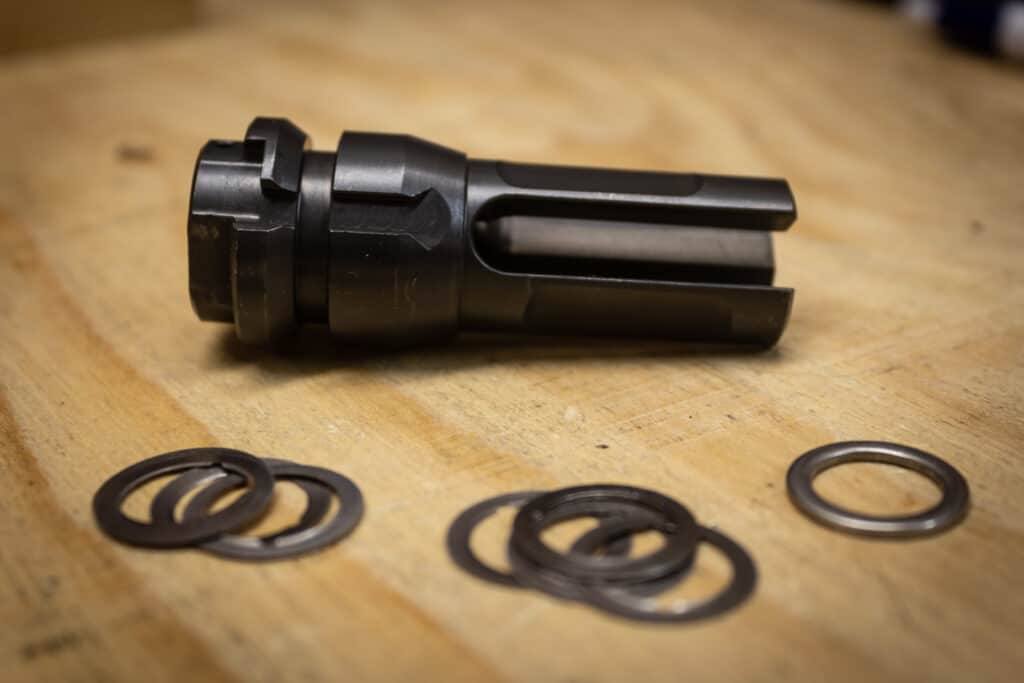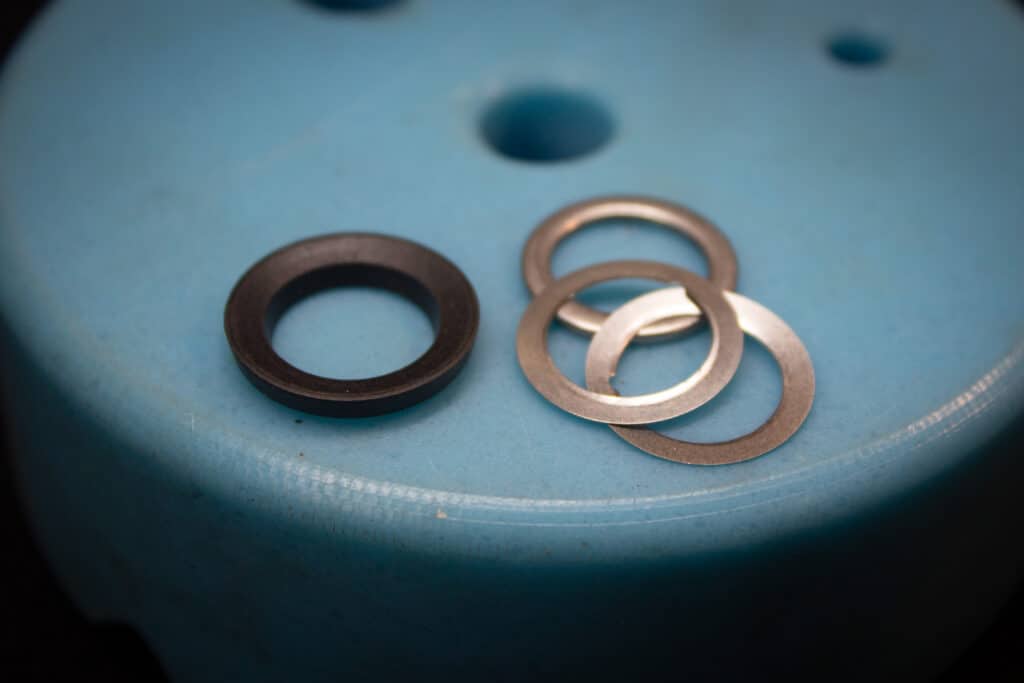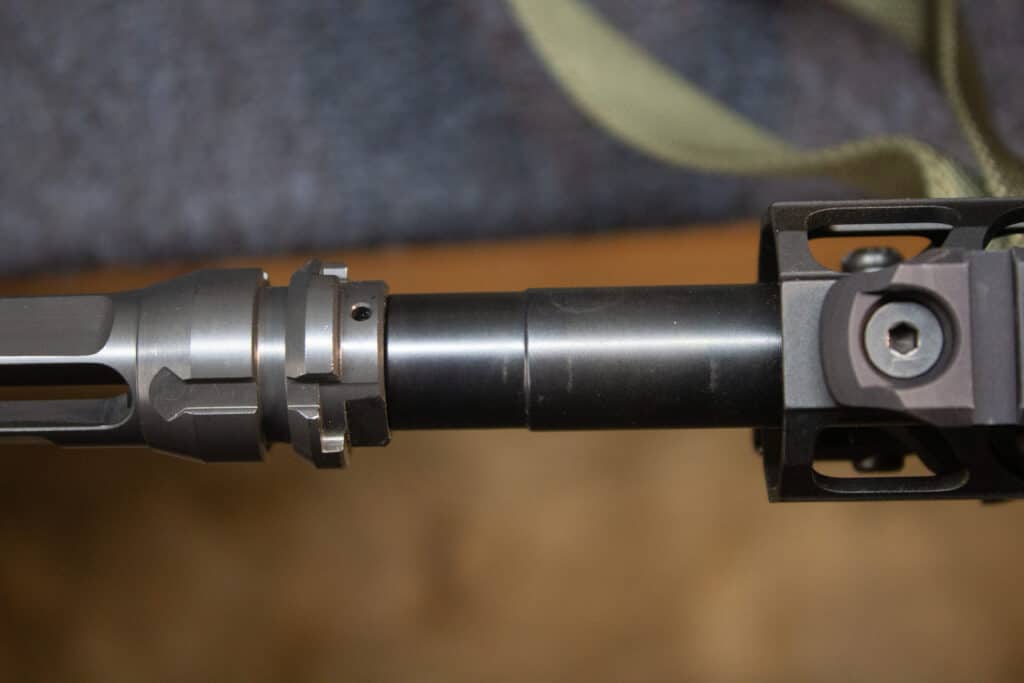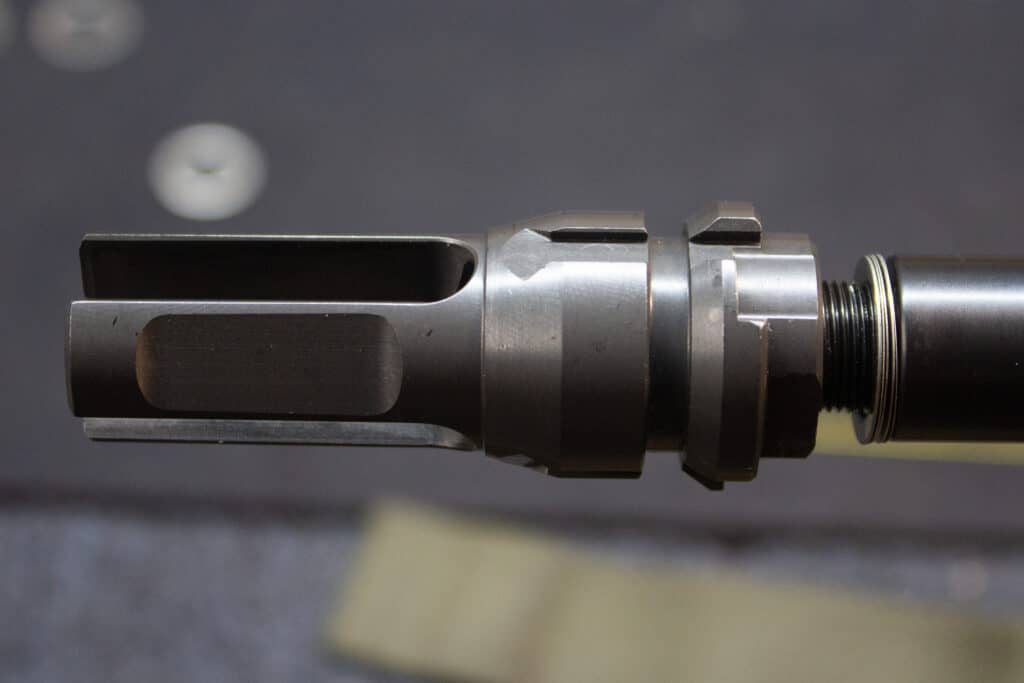
Timing a muzzle device can be an absolute pain. Install it. Remove it. Add shims. Install it. Remove it. Rinse and repeat. There is a much easier way. Using the simple formula below, you will have the correct amount of shims the second time you install the muzzle device on the barrel.
Affiliate Disclosure: This article may contain affiliate links. When you use these links, I earn a small commission from each sale generated at no cost to you. This commission helps me continue to put out free content. I work a full-time job that I am very happy with; therefore, I don’t need this commission and am not obligated to speak highly of any product. Everything written is my own opinion: the good, the bad, and the ugly.
Timing a Muzzle Device. Why?
Timing a muzzle device is not always necessary. Many flash hiders, including the one I am using, don’t require timing. On the Dead Air Keymount Flash Hider, a pin and weld hole is meant to be positioned at 6 o’clock on the barrel. Even though I don’t need to pin and weld this on my barrel, that is still an excellent place to position it aesthetically. On the other hand, muzzle brakes need to be timed. Plain and simple. They are designed to direct the gases that exit your muzzle in different directions to tame muzzle climb and reduce recoil.

Shims or Crush Washer?
Most factory AR-15s come with a standard flash hider or muzzle brake timed using a crush washer. That is completely okay to do if you are not going to run a suppressor. If you plan on using a suppressor, do not use crush washers; use shims. Shims are an even thickness and keep the muzzle device true to the threads on the barrel. The same is not true with crush washers, as they can cause alignment issues. Adding a six-inch suppressor to a misaligned muzzle device is asking for problems.
How Much Torque when Timing a Muzzle Device?
When in doubt, follow your manufacturer’s specifications. Dead Air recommends between 25-35 ft/lbs of torque. In this video, Mike from Dead Air said that going past 50 ft/lbs of torque can negatively affect accuracy. While I have not tested that personally, I have no reason not to believe him.

Use coupon code KTG10 to get 10% off your order of $150 or more at Brownells.
The Easy Formula for Timing a Muzzle Device
It took screwing and unscrewing my flash hider three times before I thought there had to be a better way. After some thought, I realized it is the same formula as timing a screw, just in reverse. In this case, you are adding material instead of removing it. I did the math, and sure enough, it worked!
(A x B) + 0.002 = C
The formula is a pretty simple one. I’ll break it down into three parts to simplify it even further.
A = 1 / TPI = 1 / 28 = 0.0357
A – Is one divided by the threads per inch(TPI) of your muzzle. Find the TPI using a thread pitch gauge or look up the manufacturer’s specs. For this example, my 5.56 AR-15 has a 1/2-28 thread or 28 TPI.

B = Fractional Rotation = 11 / 12 = 0.9166
B – Calculate this as a fraction of the amount of rotation you want the muzzle device to make. I find it easiest to use clock positions as everyone is familiar with them. These clock positions are referenced by looking at the muzzle from the front of the firearm. Install your muzzle device and make it hand-tight. My muzzle device needs to go one clock position forward from 5 to 6 o’clock. One clock position is 1/12 of a fractional rotation.
When going forward a clock position, subtract that number from 12. When going back clock positions, say from 9 to 6 o’clock, leave the number as is. Once again, these clock positions are referenced from in front of the muzzle. For my example, the fractional rotation will be 11/12, 0.9166 in decimal form.

C = ( A x B ) + 0.002 = ( 0.0357 x 0.9166 ) + 0.002 = 0.0347″
C – Lastly, multiply A * B, then add 0.002. This 0.002″ accounts for any crush you might get when torquing the muzzle device. I round this number down to the nearest thousandth (X.XXX). In this case, we need our shims to add a total thickness of .034″.
C = the total thickness of shims you will need to add.

Timing a Muzzle Device the Easy Way
Dead Air 1/2×28 muzzle devices include ten shims that are three different thicknesses. The quantities are as follows: 4 x .004″, 5 x .006″, and 1 x .060″. Dead Air was kind enough to provide a series of notches in these shims to make them easy to identify for the user. In this case, I need a total thickness of .034″. To get that, I used five of the .006″ shims and one of the .004″. When torqued to 30 ft-lbs, this perfectly lined the pin and weld hole up at 6 o’clock.
This isn’t the only way to time a muzzle device using shims, but it works. Try this, and let me know how it works for you!

Written by: Kurt Martonik
Kurt is a Gunsmith, Reloader, Hunter, and Outdoorsman. He grew up in Elk County, Pennsylvania, where he became obsessed with the world of firearms. Following high school, Kurt enlisted in the United States Air Force as a Boom Operator, where he eventually rose to the position of Instructor. After his military service, he attended the Colorado School of Trades(CST) in Lakewood, CO for gunsmithing. Following graduation, he accepted a job at C. Sharps Arms in Montana, where he worked as a full time stockmaker and gunsmith.